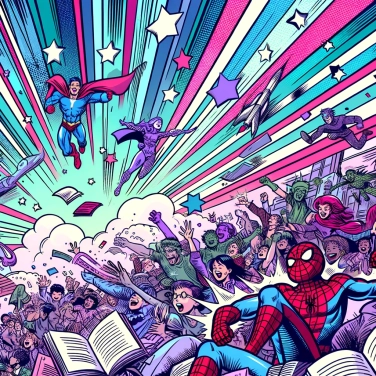Comics are popular among children because of their visually appealing nature, captivating stories, and the ease with which they allow young readers to identify with characters and stimulate their imagination.

Comic books appeal to children primarily because they are filled with colorful, fun, and expressive images. The dynamic drawings, bright colors, and well-crafted illustrations naturally capture attention. With their easy-to-follow panels, children quickly spot what’s happening: a chase jumping from one panel to another, bursts of laughter thanks to the funny facial expressions of the characters, and even illustrated sound effects like "BOOM!" or "SPLASH!". All this visual richness effortlessly sparks the imagination, makes one want to dive into the story, and simply put, it's just enjoyable to look at.
Comics often tell a story with a very lively and energetic pace. From the very first panels, children are plunged directly into the action thanks to quick events and bold scene transitions. This immediately grabs their attention, and they have no time to get bored. The plot gradually unfolds through new and bouncing twists and turns. For example, chase scenes, unexpected problems, or surprising plot twists maintain a constant narrative tension. This makes young readers eager to turn the pages again and again to find out what happens next. The dynamic narrative keeps children engaged and curious, enhancing their enjoyment of reading.
Kids easily bond with the likable and colorful characters found in comic books. When a character is funny, brave, or clumsy, the child spontaneously identifies with them: they resonate with their adventures, laugh at their antics, and imagine living the same experiences. Heroes like Titeuf, Asterix, or Spirou are quickly perceived as friends by the young reader, which strengthens their desire to collect all their albums. These characters then become familiar, almost real, and encourage children to keep reading just to follow what will happen to them again and again.
Humor immediately speaks to children because it involves funny, unexpected, or even silly situations that they understand effortlessly. Visual gags, such as exaggerated faces or absurd falls, work perfectly as they instantly provoke laughter. Children also love comedy of repetition, like a character who falls into the same trap every time, because they know exactly what to expect and find it even funnier when it happens. Simple puns and funny dialogues add an extra layer of humor, stimulating their imagination and enjoyment of reading. In short, humor creates a positive experience that makes reading enjoyable and encourages children to return to it willingly.
Comics are very popular with children because they mix text and drawings. As a result, even those who struggle a bit with reading can easily understand what is happening thanks to the images. Often, the texts are in speech bubbles and very short, which reassures young beginner readers. Moreover, the reading is done box by box, which helps to follow the story without getting lost. Comics thus quickly build confidence in children, without discouragement or hassle.
Modern comic books, as we know them today, trace their origins back to the 19th century with figures like Rodolphe Töpffer, who is often regarded as the pioneer of the genre in Europe.
According to some studies in pedagogy, comic books facilitate vocabulary learning and improve understanding of emotions and facial expressions in children.
In 2019, the French comic book market accounted for over 48 million copies sold, confirming the special affection that young readers have for this format.
The famous comic book character Asterix has been translated into over 100 languages, making this series one of the most widely distributed in the world.
Yes, many comics address educational themes: history, nature, science, and citizenship. These playful formats facilitate learning by captivating children's curiosity and attention in a more fun and accessible way.
Prioritize the age indicated by the publisher and check that the themes addressed are suitable for your child's maturity and interests. Ideally, also involve your child directly in the selection process, so that they genuinely enjoy the story.
Not necessarily to replace, but they perfectly complement traditional novels or children's books. Reading comics allows for a varied reading experience, stimulates the imagination, and enhances visual narrative understanding.
Thanks to their vivid illustrations and short dialogues, comic books make it easier to understand the story and naturally encourage continued reading. This allows children to easily advance their decoding skills, vocabulary, and their ability to comprehend a narrative.
Comic books are accessible from the age of 4 or 5, with titles specifically created for very young readers who are not yet proficient at reading. Some collections offer short, illustrated stories specifically tailored for toddlers.

No one has answered this quiz yet, be the first!' :-)
Question 1/5